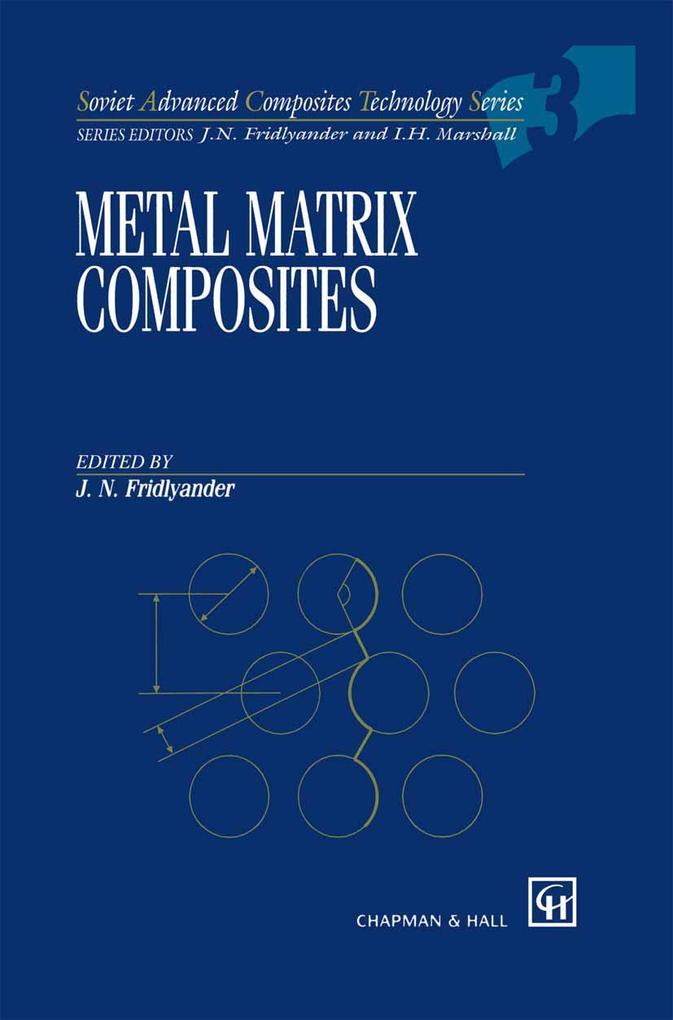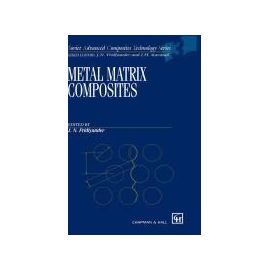
ISBN: 9780412582608
The problem of developing metal matrix (MCM) and metal-polymer (MPCM) composite materials is one of the most important in present day materials technology, for its solution is pivotal t… Mehr…
| Springer.com new in stock. Versandkosten:zzgl. Versandkosten. (EUR 0.00) Details... |

ISBN: 9780412582608
This volume deals with an exceptionally broad range of metal matrix composite materials, including a number of novel combinations which have received little attention in the past. The … Mehr…
| Indigo.ca new in stock. Versandkosten:zzgl. Versandkosten. Details... |

ISBN: 9780412582608
Gebundene Ausgabe
*Metal Matrix Composites* - Auflage 1995 / Taschenbuch für 655.49 € / Aus dem Bereich: Bücher, Taschenbücher, Ratgeber Medien > Bücher nein Taschenbuch Hardcover;Naturwissenschaften, Medi… Mehr…
| Hugendubel.de Versandkosten:Shipping in 2 weeks, , Versandkostenfrei nach Hause oder Express-Lieferung in Ihre Buchhandlung., DE. (EUR 0.00) Details... |

1994, ISBN: 9780412582608
1995 ed., Hardcover, Buch, [PU: Chapman and Hall]
| lehmanns.de Versandkosten:Versand in 15-20 Tagen, , Versandkostenfrei innerhalb der BRD. (EUR 0.00) Details... |

| Rakuten.fr |

ISBN: 9780412582608
The problem of developing metal matrix (MCM) and metal-polymer (MPCM) composite materials is one of the most important in present day materials technology, for its solution is pivotal t… Mehr…
ISBN: 9780412582608
This volume deals with an exceptionally broad range of metal matrix composite materials, including a number of novel combinations which have received little attention in the past. The … Mehr…

ISBN: 9780412582608
Gebundene Ausgabe
*Metal Matrix Composites* - Auflage 1995 / Taschenbuch für 655.49 € / Aus dem Bereich: Bücher, Taschenbücher, Ratgeber Medien > Bücher nein Taschenbuch Hardcover;Naturwissenschaften, Medi… Mehr…

1994, ISBN: 9780412582608
1995 ed., Hardcover, Buch, [PU: Chapman and Hall]

ISBN: 9780412582608
Livre, [PU: Chapman & Hall]
Bibliographische Daten des bestpassenden Buches
| Autor: | |
| Titel: | |
| ISBN-Nummer: |
Detailangaben zum Buch - Metal Matrix Composites
EAN (ISBN-13): 9780412582608
ISBN (ISBN-10): 0412582600
Gebundene Ausgabe
Taschenbuch
Erscheinungsjahr: 1994
Herausgeber: SPRINGER NATURE
704 Seiten
Gewicht: 1,148 kg
Sprache: eng/Englisch
Buch in der Datenbank seit 2007-08-14T21:08:36+02:00 (Vienna)
Detailseite zuletzt geändert am 2023-07-25T21:01:12+02:00 (Vienna)
ISBN/EAN: 9780412582608
ISBN - alternative Schreibweisen:
0-412-58260-0, 978-0-412-58260-8
Alternative Schreibweisen und verwandte Suchbegriffe:
Autor des Buches: fridl
Titel des Buches: advanced composites, matrix, metal
Daten vom Verlag:
Autor/in: J. Fridlyander
Titel: Soviet Advanced Composites Technology Series; Metal Matrix Composites
Verlag: Springer; Springer Netherland
682 Seiten
Erscheinungsjahr: 1994-12-31
Dordrecht; NL
Sprache: Englisch
534,99 € (DE)
549,99 € (AT)
590,00 CHF (CH)
Available
XI, 682 p.
BB; Hardcover, Softcover / Technik/Maschinenbau, Fertigungstechnik; Werkstoffprüfung; Verstehen; Aluminium; composite; composite materials; deformation; glass; metal; micromechanics; Characterization and Analytical Technique; Metals and Alloys; Materialwissenschaft; BC
1 Physio-chemical fundamentals of metal matrix composites.- 1.1 Formation of metal matrix composite structure and properties during the production process.- 1.2 Principles of metal matrix composite development and optimization.- 1.3 Conclusions.- References.- 2 Basic components used in the production of metal composites.- 2.1 Fibrous reinforcing agents.- 2.2 Dispersed strengtheners.- 2.3 Matrix alloys.- References.- 3 Metal matrix composite fabrication methods.- 3.1 Solid-phase fabrication methods (V.M. Tchubarov).- 3.2 Liquid-phase fabrication methods (A.A. Zabolotsky).- 3.3 Moulding of structural components from metal composite materials (G.A. Krivov).- Notation.- References.- 4 Composites of the aluminium—boron system.- 4.1 General.- 4.2 Boron—aluminium production procedure.- 4.3 Strength under static load.- 4.4 Strength at elevated temperature.- 4.5 Impact strength.- 4.6 Strength under cyclic load.- 4.7 Employment of boron-aluminium.- References.- 5 Composites of the magnesium-boron system.- 5.1 Obtaining magnesium—boron composite materials by solid-phase combination.- 5.2 Obtaining magnesium-boron composite materials by liquid-phase combination.- 5.3 Corrosion resistance of magnesium-boron composite materials.- Notation.- References.- 6 Composite materials of the aluminium—carbon system.- 6.1 Composite materials based on an aluminium matrix reinforced with carbon fibers (V.I. Kostikov and V.C. Kilin).- 6.2 Aluminium-carbon system composites (A.A. Zabolotsky).- Notation.- References.- 7 Composites of the aluminium—steel system.- 7.1 Selection of fibres.- 7.2 Selection of matrix.- 7.3 Manufacturing techniques.- 7.4 Kinetics of formation and growth of intermetallic compounds on phase boundaries.- 7.5 Properties.- 7.6 Manufacturing of CAS-type material.- 7.7Properties of structural elements.- 7.8 Thermal effects on interaction.- 7.9 Summary.- Notation.- References.- 8 Composite materials of aluminium—silicon carbide system.- 8.1 General.- 8.2 Analysis of composition and morphology of reinforcing fillers and admixture phases.- 8.3 Chemical properties of reinforcing fillers.- 8.4 Purification of reinforcing fillers of admixture phases.- 8.5 Obtaining composite materials by infiltration under pressure.- 8.6 Obtaining materials by methods of powder metallurgy.- 8.7 Prospective uses of Al—SiC composite materials.- References.- 9 Laminated fibrous metal—polymer composites.- 9.1 Introduction.- 9.2 Components of laminated fibrous metal—polymer composites.- 9.3 Properties and specific features of laminated-fibrous metal—polymer composites under static loading.- 9.4 Specific features of fatigue fracture of laminated fibrous metal—polymer composites.- 9.5 Damping properties of laminated fibrous metal—polymer composites.- 9.6 Production of parts and structures from laminated fibrous metal—polymer composites.- 9.7 Resistance of aluminium—organic plastic composites to environmental and corrosive effects.- 9.8 Conclusions.- Notation.- References.- 10 Mechanical testing of composite materials.- 10.1 Tension testing.- 10.2 Compression testing.- 10.3 Shear testing.- 10.4 Crack-resistance testing.- 10.5 Fatigue testing.- Notation.- 11 Theoretical and experimental research into the strength and deformation of fibrous metal composite materials.- 11.1 Materials investigated.- 11.2 Stretching in the reinforcement direction.- 11.3 Compression in the reinforcement direction.- 11.4 Compression perpendicular to the reinforcement.- 11.5 Three-point bending.- 11.6 Cyclic tension in the reinforcement direction.- 11.7 Deformation anddestruction of orthogonally reinforced metal composite materials under tensile stress.- Notation.- References.- 12 Structural micromechanics of elasto-plastic deformation of composites.- 12.1 Induced defects on interfaces.- 12.2 Stress fields of reinforcing fibres.- 12.3 Disinclination formation on edges of faceted reinforcing particles or fibres.- 12.4 Residual stresses elastically heterogeneous plastically deformed materials.- 12.5 Resistance to deformation.- 12.6 Specific energy of internal stresses as damaging factor.- 12.7 Structural levels.- References.Weitere, andere Bücher, die diesem Buch sehr ähnlich sein könnten:
Neuestes ähnliches Buch:
9789401045520 Metal Matrix Composites J. Fridlyander Editor (J. Fridlyander)
- 9789401045520 Metal Matrix Composites J. Fridlyander Editor (J. Fridlyander)
- 9780444596703 Metal Matrix Composites (G. Chadwick, L. Froyen)
- 9780387233062 Metal Matrix Composites by Nikhilesh Chawla Hardcover | Indigo Chapters (Nikhilesh Chawla; Krishan K. Chawla)
- 9780387285672 Metal Matrix Composites (Giovanni Motta)
< zum Archiv...



